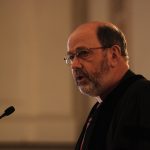We are asking various TGC Council members a simple question: Who was the first person who showed you the beauty of Jesus?
Then said Evangelist, pointing with his finger over a very wide field, “Do you see yonder Wicket Gate?” The man said, “No.” Then said Evangelist, “Do you see yonder shining light?” He said, “I think I do.” Then said Evangelist, “Keep that light in your eyes and go directly thereto. So shalt thou see the gate; at which, when thou knockest, it shall be told thee what thou shalt do.”
John Bunyan’s timeless allegory of the Christian life, Pilgrim’s Progress, has countless remarkable insights into God’s gracious dealings with sinful souls. One of those insights is that God begins working progressively in lost sinners long before they are finally converted to Christ. Though there is certainly a decisive moment when the sinner is born again (John 3:3; 5:24), the groundwork is laid before that moment. So it was with me. I saw the diffused and distant light of the beauties of Jesus Christ long before I crossed over from death to life.
But I needed an Evangelist to point me to the true way.
Distant Light
I was raised as a Roman Catholic, and through regular church attendance and instruction by my parents, I knew the basic story of Jesus Christ. From my childhood I was powerfully attracted to Jesus: I was fascinated by him and desired to know more. But I didn’t know him, not savingly. Week after week, I attended St. Anselm’s Catholic Church in Sudbury, Massachusetts, and listened to the words of the Mass. I learned some things about Jesus—his miracles, his kindness to the poor, some of his teachings, and the facts of his birth, life, death, and resurrection. But how his works and words should relate to a sinner like me wasn’t clear at all.
I remember serving as an altar boy at the “stations of the cross” service, held on Good Friday afternoon. This service entailed a progressive “pilgrimage” through our sanctuary, standing in front of one stained-glass window after another that depicted aspects of Christ’s final hours on earth. I listened to the readings and said the rote prayers. I saw the sunlight streaming through the stained-glass art and took it in. But I still didn’t understand from Scripture that Christ had to rise from the dead (John 20:9). His full glories were hidden from me by my own sinful blindness and by the failure of the church to preach the clear gospel from the Bible. By the grace of God, I did see the distant light of his glory in these in these shrouded and imperfect means, but I wouldn’t see clearly until my junior year at M.I.T.
My first two years at M.I.T. were spent enjoying the normal life of a student: living in a fraternity, going to engineering classes, playing intramural sports, staying up way too late, and having lots of college fun. Church was no part of that program. My thoughts of Jesus were fewer and fewer; the distant light was getting dimmer and dimmer. And a spiritual depression was creeping over my soul, a pervading sadness at the emptiness of everything I was doing or hoped to do.
Conversion
In his kindness, God brought two key people into my life to point me to the glories of Christ. The first was my Evangelist, Steve Chamberlain. Steve was a fraternity brother who patiently and lovingly shared the gospel with me and invited me to Campus Crusade for Christ (Cru) meetings. He lived out his faith in Christ before my eyes, showing me that loving Christ could be woven into the fabric of every single day. For the first time in my life, he opened the Bible and read portions of the New Testament to me.
Steve lived out his faith before my eyes, showing me that loving Christ could be woven into the fabric of every single day.
But as attractive as that was, it was hard for me to be around him in the final months of my unconverted life. The invisible light of Christ’s glory also reveals the hidden darkness of sin in those he’s come to save. And seeing my sinfulness stung. I blamed Steve, and became increasingly rude to him. But his patient love toward me was a key tool in the Spirit’s hands for my eventual conversion. Steve put Christ’s mercy on display in his life, and showed me where to find it in the Bible. And he boldly invited me to the fall retreat in Groton, Massachusetts, where I finally trusted in Christ as my Lord and Savior.
Discipleship
Then God brought Tim Schuman, a staff worker with Cru, into my life. He powerfully opened up the beauties of Christ through the Word of God and the Spirit-filled life. He met with me weekly and taught me how to study Scripture systematically. He encouraged me to memorize Bible passages through the Topical Memory System of the Navigators. He brought me to a healthy, Bible-preaching church where I met Christians of all ages. He demonstrated how to live for Christ’s glory in simple day-to-day activities like tuning up a car and making scrambled eggs for breakfast. He challenged me to evangelize lost people, and he took me along with him while he showed me how to do it.
All those years ago, I saw Christ’s beauty through the Scriptures that those two men faithfully unfolded to my ears and lived before my eyes.
I’ve since come to realize how few Christians ever get to be carefully mentored like I was—discipled in all aspects of a daily walk with Christ. Tim’s love for verse-by-verse exegesis, through the radio ministry of John MacArthur, set the pattern from my lifelong approach to the Bible, allowing me to see the glory of God in the face of Christ as depicted in line after line of Scripture.
It has been 37 years since those early days of my Christian life. I’ve seen vastly more of the beauties of Jesus Christ in those years. And I know that we will spend eternity drinking in Christ’s glories in the new heavens and new earth. But all those years ago, I first saw his beauty through the Scriptures that those two men faithfully unfolded to my ears and lived before my eyes. I am eternally grateful to them both.
You can read previous installments in this series.
Is there enough evidence for us to believe the Gospels?
 In an age of faith deconstruction and skepticism about the Bible’s authority, it’s common to hear claims that the Gospels are unreliable propaganda. And if the Gospels are shown to be historically unreliable, the whole foundation of Christianity begins to crumble.
In an age of faith deconstruction and skepticism about the Bible’s authority, it’s common to hear claims that the Gospels are unreliable propaganda. And if the Gospels are shown to be historically unreliable, the whole foundation of Christianity begins to crumble.


































